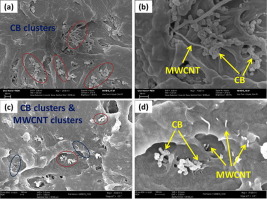当前位置:
X-MOL 学术
›
Eur. Polym. J.
›
论文详情
Our official English website, www.x-mol.net, welcomes your
feedback! (Note: you will need to create a separate account there.)
Electrical and vapor sensing behaviors of polycarbonate composites containing hybrid carbon fillers
European Polymer Journal ( IF 5.8 ) Pub Date : 2018-11-01 , DOI: 10.1016/j.eurpolymj.2018.09.027 Yilong Li , Petra Pötschke , Jürgen Pionteck , Brigitte Voit
European Polymer Journal ( IF 5.8 ) Pub Date : 2018-11-01 , DOI: 10.1016/j.eurpolymj.2018.09.027 Yilong Li , Petra Pötschke , Jürgen Pionteck , Brigitte Voit

|
Abstract The vapor sensing behaviors of conductive polymer composites (CPCs) fabricated by dispersing multi-walled carbon nanotubes (MWCNT) and carbon black (CB) in polycarbonate (PC) via melt mixing were studied. Two MWCNT contents of 0.10 and 0.50 wt% were selected, which were respectively lower and higher than the electrical percolation threshold of PC/MWCNT composites (0.11 wt%), and different CB contents ranging from 0.5 to 2.5 wt% were added. The chemo-resistive properties with different hybrid filler contents were investigated by exposing CPC strips to different organic vapors. The vapor sensing response was found to be well correlated to the Flory-Huggins interaction parameter between the solvents and PC. Acetone with the strongest interaction resulted in highest responses, followed by toluene, whereas cyclohexane, as the solvent with the weakest interaction to PC, caused only very low sensing responses. Irrespective of the solvent, the highest relative resistance changes during cyclic sensing were found for the composite with 0.1 wt% MWCNT and 1.5 wt% CB, which has the lowest network density. The responses after the first immersion cycle, which can be regarded as equilibration cycle, were the highest for this composite in toluene and cyclohexane. In acetone, the composite with 0.5 wt% MWCNT and 1.5 wt% CB, having the network formed mainly by MWCNTs, showed the highest sensing response.
中文翻译:

含有混合碳填料的聚碳酸酯复合材料的电和蒸汽传感行为
摘要 研究了通过熔融混合将多壁碳纳米管(MWCNT)和炭黑(CB)分散在聚碳酸酯(PC)中制备的导电聚合物复合材料(CPC)的蒸汽传感行为。选择了 0.10 和 0.50 wt% 的两种 MWCNT 含量,分别低于和高于 PC/MWCNT 复合材料的电渗透阈值(0.11 wt%),并添加了 0.5 至 2.5 wt% 的不同 CB 含量。通过将 CPC 条暴露于不同的有机蒸气中,研究了具有不同混合填料含量的化学电阻性能。发现蒸汽感应响应与溶剂和 PC 之间的 Flory-Huggins 相互作用参数密切相关。相互作用最强的丙酮导致最高的响应,其次是甲苯,而环己烷,作为与 PC 相互作用最弱的溶剂,仅引起非常低的传感响应。不考虑溶剂,在循环传感过程中发现最高相对电阻变化对于具有 0.1 wt% MWCNT 和 1.5 wt% CB 的复合材料,其具有最低的网络密度。在第一次浸入循环后的响应,可视为平衡循环,在甲苯和环己烷中该复合材料的响应最高。在丙酮中,具有 0.5 wt% MWCNT 和 1.5 wt% CB 的复合材料,主要由 MWCNTs 形成网络,显示出最高的传感响应。在第一次浸入循环后的响应,可视为平衡循环,在甲苯和环己烷中该复合材料的响应最高。在丙酮中,具有 0.5 wt% MWCNT 和 1.5 wt% CB 的复合材料,主要由 MWCNTs 形成网络,显示出最高的传感响应。在第一次浸入循环后的响应,可视为平衡循环,在甲苯和环己烷中该复合材料的响应最高。在丙酮中,具有 0.5 wt% MWCNT 和 1.5 wt% CB 的复合材料,主要由 MWCNTs 形成网络,显示出最高的传感响应。
更新日期:2018-11-01
中文翻译:

含有混合碳填料的聚碳酸酯复合材料的电和蒸汽传感行为
摘要 研究了通过熔融混合将多壁碳纳米管(MWCNT)和炭黑(CB)分散在聚碳酸酯(PC)中制备的导电聚合物复合材料(CPC)的蒸汽传感行为。选择了 0.10 和 0.50 wt% 的两种 MWCNT 含量,分别低于和高于 PC/MWCNT 复合材料的电渗透阈值(0.11 wt%),并添加了 0.5 至 2.5 wt% 的不同 CB 含量。通过将 CPC 条暴露于不同的有机蒸气中,研究了具有不同混合填料含量的化学电阻性能。发现蒸汽感应响应与溶剂和 PC 之间的 Flory-Huggins 相互作用参数密切相关。相互作用最强的丙酮导致最高的响应,其次是甲苯,而环己烷,作为与 PC 相互作用最弱的溶剂,仅引起非常低的传感响应。不考虑溶剂,在循环传感过程中发现最高相对电阻变化对于具有 0.1 wt% MWCNT 和 1.5 wt% CB 的复合材料,其具有最低的网络密度。在第一次浸入循环后的响应,可视为平衡循环,在甲苯和环己烷中该复合材料的响应最高。在丙酮中,具有 0.5 wt% MWCNT 和 1.5 wt% CB 的复合材料,主要由 MWCNTs 形成网络,显示出最高的传感响应。在第一次浸入循环后的响应,可视为平衡循环,在甲苯和环己烷中该复合材料的响应最高。在丙酮中,具有 0.5 wt% MWCNT 和 1.5 wt% CB 的复合材料,主要由 MWCNTs 形成网络,显示出最高的传感响应。在第一次浸入循环后的响应,可视为平衡循环,在甲苯和环己烷中该复合材料的响应最高。在丙酮中,具有 0.5 wt% MWCNT 和 1.5 wt% CB 的复合材料,主要由 MWCNTs 形成网络,显示出最高的传感响应。











































 京公网安备 11010802027423号
京公网安备 11010802027423号